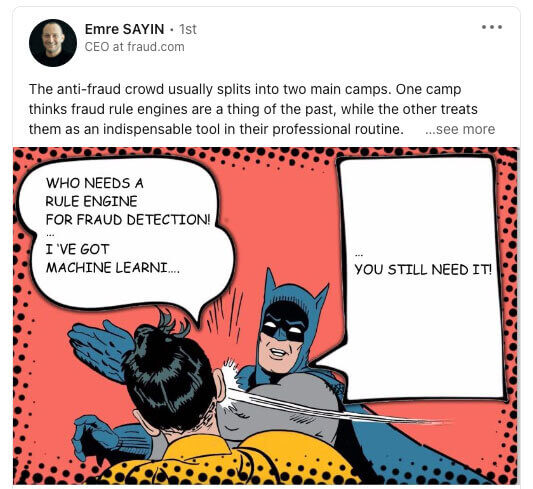The world of fraud prevention is continuously evolving, where two main mechanisms – fraud rule engine-based systems and machine learning – both work towards the same goal of fighting fraud. A common type of debate is centered around a question: are fraud rule engines a relic of the past? How do anti-fraud powered by rule engine systems fit into the landscape of modern fraud management systems? In this article, we will delve into this ongoing dialogue and reveal how these seemingly divergent mechanisms form a highly efficient fraud prevention solution.
These two components work to help us prevent fraud in today’s complex world. If you would like to join the discussion on LinkedIn about this topic, please take a look at the LinkedIn post here, shared by Emre Sayın.

In the debate over fraud rule engines’ relevance, an image featuring Batman and Robin playfully tackles the issue. Robin says, “Who needs a rule engine for fraud detection! I’ve got machine learning” Batman responds, “You still need it!” resulting in a playful slap. This amusing snapshot reminds us that, in fraud prevention’s evolving world, humour can spice up discussions on rule engines’ future. These two, rule engines and machine learning, protect against fraud, blending tradition and innovation!
Table of Contents
ToggleWhat are fraud detection rule engines, and how do they work?
Simply put, fraud detection rule engines are like intelligent computer programs that actively combat fraudulent activities. The engines work by analyzing data points from financial transactions or user interactions and comparing them to a pre-set list of ‘rules’.
Here’s a more in-depth look into the process, incorporating some key phases:
- Setting the rules: Through neural networks and advanced learning systems, these engines create rules based on historical data, industry norms, types of rules like regulatory requirements, and past patterns of fraudulent activities, such as identity theft, bank fraud, credit card fraud, and money laundering.
- Data entry: These rules-based system engines are continually monitoring and analyzing incoming data, such as financial transactions or user interactions. They are especially adept at processing large volumes of data points, providing a comprehensive overview for effective fraud scoring.
- Checking the rules: This data is then checked against the set rules. If any aspect of the data breaks these rules, such as a sudden spike in transaction amounts or activities from dubious locations, the system springs into action.
- Response: The final step is responding to a violation. This could be as simple as sending an alert for someone to further investigate, or it could be an automatic action like blocking a suspicious transaction.
Despite the rapid advancement of machine learning its advantages in fraud prevention and its impressive ability to identify subtle, complex patterns within data, traditional rules engines remain a vital part of fraud detection. They continually evolve, adapting their rule sets swiftly to new fraud techniques including sophisticated fraud schemes, thereby providing a stable framework within the ever-fluctuating world of fraud detection and prevention.
In a nutshell, though rule engines have a longstanding history in fraud prevention, they are far from redundant. They are dynamic, constantly adapting tools that continue to play an essential part in shaping our strategies against fraud. Through robust fraud scoring and adaptability in rule formulation, these engines capably reinforce the wall against fraudulent activities.
The evolution of fraud detection
Fraud has evolved over time and the realm of fraud detection has also undergone a profound transformation in recent years, driven primarily by the rapid advancements in the technology used to fight fraud and the increasing sophistication of fraudulent schemes. Traditional methods and conventional tools have found themselves challenged by the ever-growing complexity of fraud attempts.
In this context, the rise of decision systems, driven by advanced machine learning algorithms, has garnered significant interest and fascination among many in the anti-fraud community. These decision systems have been celebrated as the game-changers in the fight against fraud, possessing the ability to analyze vast volumes of data in real time, making them exceptionally agile and precise in their fraud detection capabilities.
Bringing back fraud rule engines: Modern and improved
In an ever-evolving landscape of fraud detection, there’s a compelling story unfolding around fraud rule engines. These unassuming tools, sometimes considered relics of the past, are experiencing a modern-day revival that’s anything but static.
- Adapting to modern challenges: While it’s true that some sceptics have questioned their relevance, fraud rule engines have demonstrated an impressive capacity to adapt and evolve. In fact, their role in modern fraud detection has become increasingly dynamic.
- Steadfast and agile: One of the most remarkable aspects of fraud rule engines is their ability to provide a steadfast foundation while remaining highly agile. Unlike static relics, they’ve embraced the challenges of the digital age, continuously updating their rule sets to combat ever-shifting fraudulent tactics.
- Empowering decision-making: In today’s high-stakes world of fraud prevention, these engines empower decision-makers with real-time insights and instant responses. They serve as the reliable guardians of financial integrity, supporting organizations in their mission to safeguard against fraud.
- The power of automation: Automation lies at the heart of their resurgence. Fraud rule engines efficiently process vast amounts of data, swiftly identifying anomalies and suspicious activities that may elude human detection. This proactive approach is crucial in a landscape where every second counts.
- An essential component: In the contemporary fight against fraud, fraud rule engines aren’t relics of a bygone era; they are vital components of a comprehensive fraud detection strategy. Their dynamic role in modern fraud detection is a testament to their enduring relevance and adaptability in an ever-changing world.
Within the expansive realm of fraud detection, a lively and ongoing debate rages on, with professionals divided into two distinct camps. One camp staunchly advocates for the retirement of traditional rule engines, deeming them relics of the past. In contrast, the other camp fervently champions the ongoing relevance and indispensability of these rule-based tools.
How fraud rule engines shape anti-fraud strategies
In a time when technological progress reshapes the limits of what we can do, the persistence of fraud detection engines serves as proof of their constant importance. These modest tools have defied forecasts of becoming outdated, persistently having a significant impact on the tactics used by companies in their tireless efforts to combat fraudulent actions.
- Formidable and resilient: Despite the ever-changing tactics employed by fraudsters, fraud rule engines have proven themselves to be formidable and resilient guardians of financial integrity. They serve as the bedrock upon which anti-fraud strategies are built, providing a reliable framework to identify and combat fraudulent activities.
- Adaptability in a shifting landscape: In the dynamic landscape of fraud detection, adaptability is paramount. Fraud rule engines have risen to the occasion, continuously evolving to meet the challenges posed by emerging fraudulent techniques. Their ability to promptly update rule sets and swiftly respond to evolving threats is a testament to their enduring vitality.
- Influence beyond prediction: These engines offer more than just predictive capabilities; they shape the very strategies employed in the battle against fraud. Their presence provides a sense of stability in an ever-evolving landscape, allowing organizations to confidently navigate the turbulent waters of fraudulent activities.
Harmonizing machine learning and fraud rule engines in fraud prevention
Picture fraud prevention as a ballroom where a unique duo is performing a harmonious dance. This dynamic duo consists of the swift-footed, agile element of machine learning and the steady, reliable partner of fraud rule engines. In a continuously shifting landscape of fraud prevention, they complement each other’s strengths while setting new benchmarks for assurance.
Machine learning, with its prowess to analyze massive data sets and identify complex patterns, is like that passionate dancer who is always ready to take the lead, explore the unknown, and adapt to ever-evolving threat choreographies.
On the other hand, like the steadfast dance partner, fraud rule engines offer much-needed stability. Grounded in historical data, these form a firm foundation with their pre-defined rules, ensuring the dance rhythm never goes out of sync.
Together, just like a perfectly choreographed ballet, they form an invincible defence against fraud. With machine learning identifying the unknown, and rule engines providing a benchmark of certainty, they fortify the fortress of fraud prevention. This partnership ensures organizations remain nimble-footed, proactive, and well-prepared to combat the ever-changing dance of fraud schemes.
While false positives are practically inevitable in fraud detection, the song of this duo can dramatically tone down such instances. Picture machine learning as that composer who, with an intuitive sense of rhythm, can pick out even the most subtle discrepancies in notes, identifying any potential bad melody of fraudulent activities. Simultaneously, our reliable rules engines serve as the committed conductor, guiding the orchestra with their baton of predetermined rules, assuring every note falls into place correctly.
As our dance continues, remember, that while machine learning may come with a wave of enthusiasm and new possibilities, let’s not forget that the grace and reliability of the timeless dance of the fraud rule engines still hold a pivotal place in this ballroom. Like the crucial beats to any melody, their presence in the spheres of fraud prevention can never be overstated.
In conclusion, in the alluring ballroom of fraud prevention, the smooth imaginative steps of machine learning paired with consistent, timeless moves of fraud rules engines make one heck of a dance duo. So, while appreciating the novelties of machine learning, let’s not forget the continued relevance and indispensability of our expert dancer – the rule engines – a steadfast partner who has been mastering the art of this dance for ages.
aiReflex: A fraud prevention solution powered by rules-engine and machine learning
Developing solutions that adapt quickly to emerging threats in the world of fraud prevention is imperative more than ever. A perfect reflection of such a solution is aiReflex, a product of fraud.com that uses the combined power of machine learning features and the reliability of rules-based systems to tackle the ever-changing obstacles they strive to overcome.
aiReflex is a highly efficient, AI-based, all-in-one fraud prevention suite. It allows organizations to swiftly detect potential fraudulent activities by analyzing their transactions and behavioural patterns in real time. aiReflex significantly reduces false positives, proving itself to be a reliable ally for various financial institutions.
In conclusion, despite the debate on the relevance of fraud rules engines, fraud.com is committed to offering holistic solutions that harmoniously integrate the best of both worlds. Through aiReflex, we visualize how machine learning and rules-based engines can unite to create a flexible, potent, and comprehensive tool that morally empowers organizations against the bane of fraud. By harnessing the power to verify the legitimacy of transactions through the precision of machine learning and creating rules borne of experience, we ensure that organizations are equipped to prevent fraud effectively.
Join the discussion on LinkedIn about this topic here. We look forward to hearing your thoughts and insights on this important matter!









